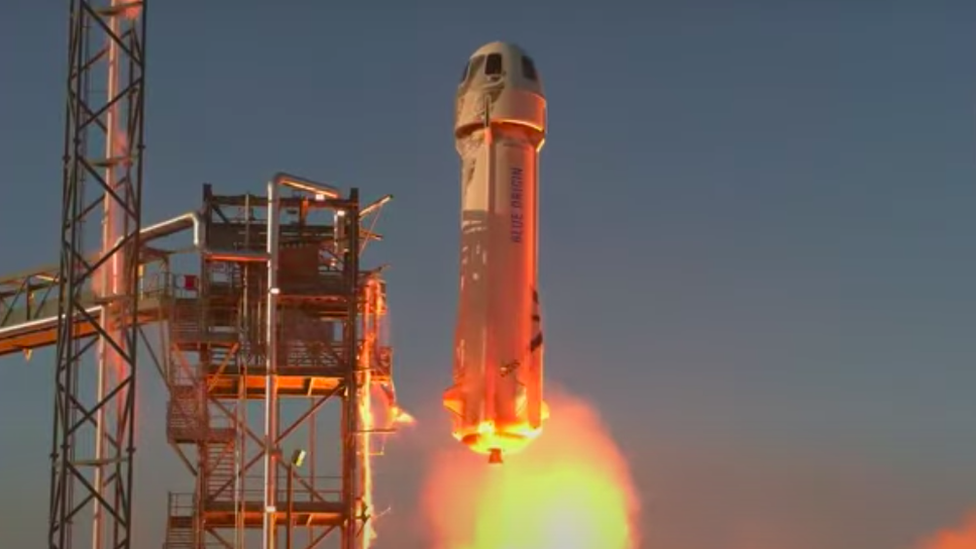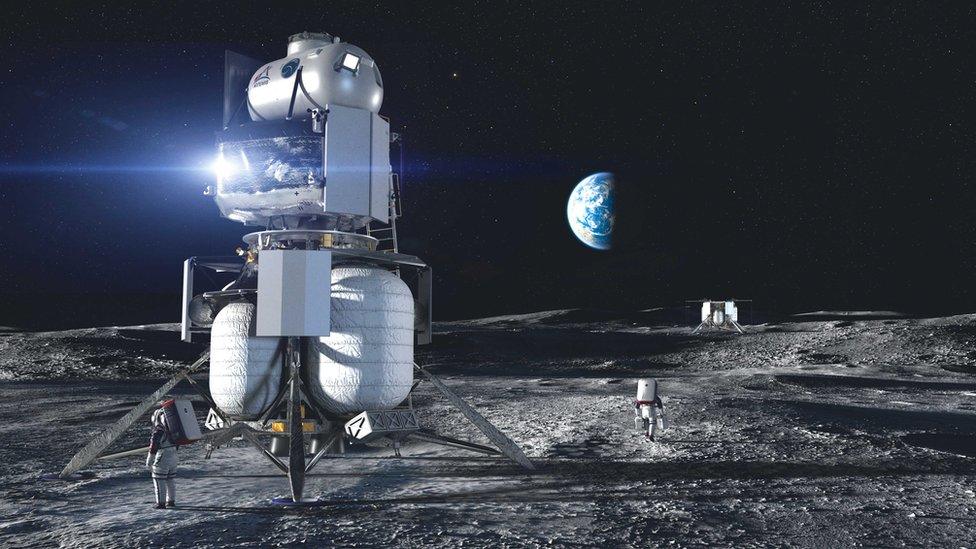New Shepard: Jeff Bezos' rocket tests Nasa Moon landing tech
- Published

Tuesday's launch took place from Blue Origin's test facility in West Texas
A rocket built by Amazon founder Jeff Bezos' space company has tested technology designed to return humans to the Moon in 2024.
The New Shepard booster, developed by Blue Origin, can land vertically on the ground after returning from space.
The rocket was carrying sensors, a computer and software designed to help space vehicles perform precision landings on other planetary bodies.
Nasa wants to try the technology on Earth before it's sent to the Moon.
Tuesday's test launch was the seventh for Blue Origin's New Shepard vehicle, which is designed to carry space tourists on short "sub-orbital" trips.
It will eventually take passengers up to around 100km (62 miles) above the Earth, allowing them to experience microgravity. They will be carried up in a crew capsule mounted on top of New Shepard.
Allow X content?
This article contains content provided by X. We ask for your permission before anything is loaded, as they may be using cookies and other technologies. You may want to read X’s cookie policy, external and privacy policy, external before accepting. To view this content choose ‘accept and continue’.
This pressurised capsule features the largest windows ever sent into space, according to the company. After reaching space, the capsule separates from the booster and both vehicles fall to Earth.
During Tuesday's test (known as NS-13), external, the capsule gently parachuted down, while the rocket performed a perfect powered landing.
"Today's flight was inspiring. Using New Shepard to simulate landing on the Moon is an exciting precursor to what the Artemis programme will bring to America," said Bob Smith, Blue Origin's chief executive.
The payload it was carrying for Nasa is called Splice, which stands for Safe and Precise Landing - Integrated Capabilities Evolution.
It consists of two sensor systems, a computer and advanced algorithms - sets of instructions designed to be implemented by a computer.
The purpose of sending it up on New Shepard was to test how the different elements of the payload work together.
"We're taking the best of Nasa sensor developments across the agency, one or two commercial offerings, putting them on the propulsion module (rocket) of New Shepard," said Stefan Bieniawski, senior engineer at Blue Origin.

Inside the crew capsule: It features the largest windows ever flown in space
"What's really valuable about the propulsion module is coming all the way back from space and doing a propulsive landing, which is very akin to what we want to do with the lunar landing."
The first of the Splice sensor systems was developed by Draper, a research organisation based in Cambridge, Massachusetts, external. It's designed to perform "terrain relative navigation", in which cameras gather real-time information about the surroundings. The images are then compared with pre-loaded maps to determine the vehicle's precise location.
Back in the 1960s, Neil Armstrong and Buzz Aldrin almost came down in a boulder field during the historic Apollo 11 landing.
The space agency wants to avoid something like this happening again, so sensor systems like Draper's are intended to make landings safer.
"[The Apollo missions'] landing target was on the order of miles, our landing target is 100 metres - or less," said Stefan Bieniawski.

Blue Origin is leading a team that has won a contract from Nasa to start developing a lunar lander
The second sensor system is called a Navigation Doppler Lidar, which was developed at Nasa's Langley Research Center in Virginia, external. It is also designed to help vehicles land precisely, but instead sends laser beams to the surface of the planetary body and detects the reflected signal to determine the vehicle's velocity and altitude.
Blue Origin is part of a team that was awarded a Nasa contract to start developing a lander capable of returning humans to the lunar surface for the first time since 1972.
Under its Artemis programme, Nasa plans to send a man and a woman to the lunar South Pole. But that would be just an early step in a bigger plan to establish a long-term presence on the Moon.
The 18m-tall New Shepard rocket blasted off at 14:36 BST (09:36 EDT) on Tuesday from Blue Origin's test facility near Van Horn, Texas. The vehicle reached a maximum altitude of 105km (346,000ft) above the ground.
Follow Paul on Twitter., external